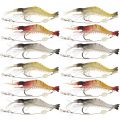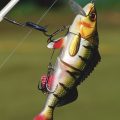
It takes a lot of patience to jig for salmon. Usually done by people with no live bait or
those who derive zero pleasure in trolling, jigging isn’t just a technique, but
a real art that’s certainly going to take you a long while before you achieve
mastery. Back before jigging became a technique worth considering, the tackle
boxes people used in the 80s and 90s featured a Buzz Bomb. That was the
outmoded version of jigging, hence the term buzz bombing. But basically, this
technically mostly involved creating a buzzing sound or vibrating noise that
were meant to irritate salmons, thus causing them to strike.
The small metal slabs employed during jigging are approximately the size and shape of
anchovies, herrings, and a series of other small bait fishes that coho, pacific
salmons and Chinook can feed on. When a jig is put in front of a famished
salmon, there’s a fair chance the fish will jump on it thinking it’s an easy
meal.
Jigs aren’t that expensive either. In which case, you’re likely to get a couple of jigs at
the same price as the cost of buying about three dozen herrings. This may sound
costly, but it isn’t when you consider the fact that a metal jig is meant to
last way longer. Plus, you do not have to suffer the smell that comes with
using a herring, anchovies, or any other fishing bait.
Jigging for Salmon
As simple as it sounds, jigging can be a little bit more complicated than you imagine. To
understand the technique and master the skill, you’ll have to begin by
understanding a few ingredients that get thrown into the mix.
Rod
The rod works a lot like mooching or trolling, with the only difference being the
equipment used are entirely different. You’ll be more interested in using
shorter rods that feature a fast taper sensitive tip and stiff butt section,
where some prefer a rod length of between 7 to 7.5 inches. Keep in mind that
the kind of rods used in jigging are very much different from those that people
use in mooching and trolling. For this case, you’re better off working with a
back-bouncing rod such as the Lamiglas Puget Jigger G13020-T model or the G.
Loomis HSR-932C.
Reel
There’ll be a lot of more cranking in this than any other method you have ever tried
before. So, it’s important that you find a reel with a retrieval ration of 4 to
1, on the very least. It’s even better if you find one with a higher retrieval
ratio such as 5 to 1. You don’t necessarily need a larger reel. You might want
to settle for something simple such as Shimano Bantam, Diawa Millionare 35,
Shimano Triton 200G, or Ambassedeur 5500. It’s however important that you
choose a reel with a top-notch drag system.
Line
You can fill the spill with about half full 20# mono and top it up with about 125 yards of
new spectra line of about 30# mono. Spectra lines are never thought to be more
effective than in this type of fishing. The core reason being it has no
stretch, in addition to featuring a small diameter that lets you fill the take
while jigging. In addition to that, it lets you reach the bottom without
stacking up much weight. Another trick would be to consider using a 6-inch mono
shock leader that’s attached to a ball-bearing swivel. This should prevent you
from pulling the hook from the mouth of a fish while hooking it out. It’s also
meant to camouflage the line from being spotted by the salmons under water.
Lure
If you’re not certain about the right bait size to use, then you may find it fit to pick
the smallest jig size you can find. Also, after you catch a salmon, cut its
stomach open and use the content there-in to figure out the right jig to match
the hatch. For salmon, brands that have proven to work include Point Wilson
Dirt, Buzz Bomb, and Crippled Herring to mention a few. For the color, you’re
better off experimenting with green, silver, white, or blue. You can increase
your odds of catching a fish by replacing the existing hook with a Siwash one.
The next thing you do is place a barrel swivel in between the jig and the hook
to keep the fish from rolling over and pulling the hook to set it loose by the
jig.
The Method
You can start by finding the bait school, jig semi-slow, and spool out line. Once done,
go ahead and jig the rod in approximately 2 feet motions, as the jig follows
the rod tip before it drops. This is meant to ensure that you stay in touch
with the lure. After getting to the bottom, the next thing you do is jig the
rod up a few feet. Just let it skip as it falls back, while raising it to up to
4 feet before letting it fall back about 2 feet, then 4 feet again, and back to
2, as the pattern continues as you continue working your way up and down past
the bait. Continue moving your jig up and down if it happens, you’re still in
the bait. If by any chance the fish takes the bait by grabbing the lure, the
jig will hit the bottom, causing the line to go slack. You can tell you’ve had
a bite when the jig starts fluttering up and down like a baitfish that’s been
wounded. At this point, it’s important that you keep the tip of your rod low to
the water, so you’ll have enough space for making a hookset. And that’s exactly
where the situation gets critical. First, you have to make sure that your mode
of fishing in the water column is as vertical as it’s humanly possible. In
whatever you do, it’s crucial that you try to make sure that you are fishing straight.
This could mean backing into the direction of the wind or current using a
trolling motor that will be helping you slow the drift. Another trick would be
to consider using a weightier jig.
It’s a Wrap
By jigging, what you’re trying to do is to imitate the motion of a bait fish using a lure. In
which case, if you can’t pull this off, what you’re basically doing some random
upper body exercise, and not fishing… good luck and practice.











